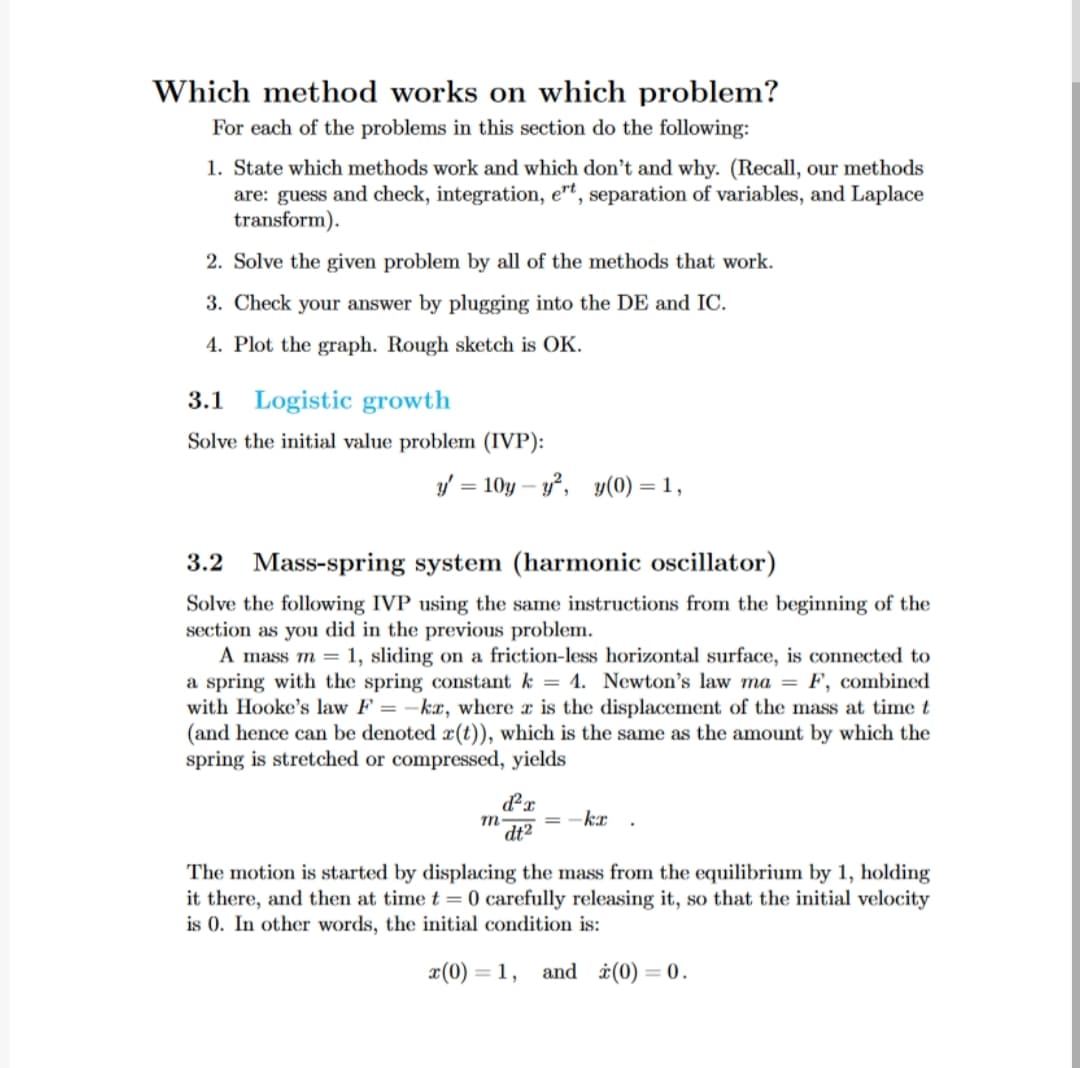3.2 Mass-spring system (harmonic oscillator) Solve the following IVP using the same instructions from the beginning of the section as you did in the previous problem. A mass m = 1, sliding on a friction-less horizontal surface, is connected to a spring with the spring constant k = 4. Newton's law ma = F, combined with Hooke's law F-ka, where a is the displacement of the mass at time t (and hence can be denoted z(t)), which is the same as the amount by which the spring is stretched or compressed, yields = d²x dt2 -kx The motion is started by displacing the mass from the equilibrium by 1, holding it there, and then at time t= 0 carefully releasing it, so that the initial velocity is 0. In other words, the initial condition is: m- x(0)=1, and (0) = 0. ż
3.2 Mass-spring system (harmonic oscillator) Solve the following IVP using the same instructions from the beginning of the section as you did in the previous problem. A mass m = 1, sliding on a friction-less horizontal surface, is connected to a spring with the spring constant k = 4. Newton's law ma = F, combined with Hooke's law F-ka, where a is the displacement of the mass at time t (and hence can be denoted z(t)), which is the same as the amount by which the spring is stretched or compressed, yields = d²x dt2 -kx The motion is started by displacing the mass from the equilibrium by 1, holding it there, and then at time t= 0 carefully releasing it, so that the initial velocity is 0. In other words, the initial condition is: m- x(0)=1, and (0) = 0. ż
Mathematics For Machine Technology
8th Edition
ISBN:9781337798310
Author:Peterson, John.
Publisher:Peterson, John.
Chapter47: Applications Of Formulas To Cutting Speed, Revolutions Per Minute, And Cutting Time
Section: Chapter Questions
Problem 41A: Compute the following problems. Express the answers to 1 decimal place. Use: T=LFN A slot 812.00...
Related questions
Question
Differential equation: can anyone here please solve 3.2 par correctly and handwritten

Transcribed Image Text:Which method works on which problem?
For each of the problems in this section do the following:
1. State which methods work and which don't and why. (Recall, our methods
are: guess and check, integration, ert, separation of variables, and Laplace
transform).
2. Solve the given problem by all of the methods that work.
3. Check your answer by plugging into the DE and IC.
4. Plot the graph. Rough sketch is OK.
3.1 Logistic growth
Solve the initial value problem (IVP):
y' = 10y-y², y(0) = 1,
3.2 Mass-spring system (harmonic oscillator)
Solve the following IVP using the same instructions from the beginning of the
section as you did in the previous problem.
A mass m = 1, sliding on a friction-less horizontal surface, is connected to
a spring with the spring constant k = 4. Newton's law ma = F, combined
with Hooke's law F = -ka, where a is the displacement of the mass at time t
(and hence can be denoted r(t)), which is the same as the amount by which the
spring is stretched or compressed, yields
d²x
dt²
m-
-kr
The motion is started by displacing the mass from the equilibrium by 1, holding
it there, and then at time t= 0 carefully releasing it, so that the initial velocity
is 0. In other words, the initial condition is:
x(0) = =1, and (0) = 0.
Expert Solution
This question has been solved!
Explore an expertly crafted, step-by-step solution for a thorough understanding of key concepts.
Step by step
Solved in 3 steps with 3 images

Recommended textbooks for you

Mathematics For Machine Technology
Advanced Math
ISBN:
9781337798310
Author:
Peterson, John.
Publisher:
Cengage Learning,

Intermediate Algebra
Algebra
ISBN:
9781285195728
Author:
Jerome E. Kaufmann, Karen L. Schwitters
Publisher:
Cengage Learning

Mathematics For Machine Technology
Advanced Math
ISBN:
9781337798310
Author:
Peterson, John.
Publisher:
Cengage Learning,

Intermediate Algebra
Algebra
ISBN:
9781285195728
Author:
Jerome E. Kaufmann, Karen L. Schwitters
Publisher:
Cengage Learning